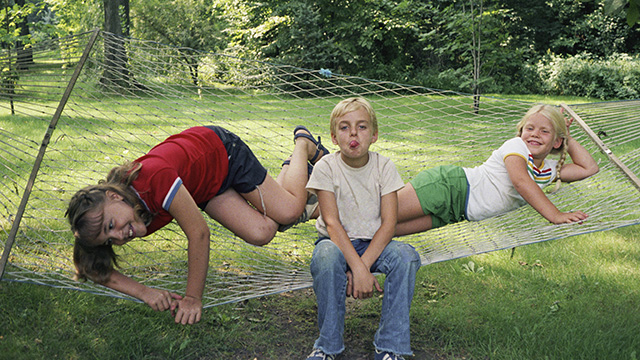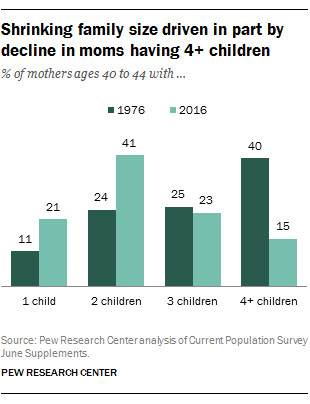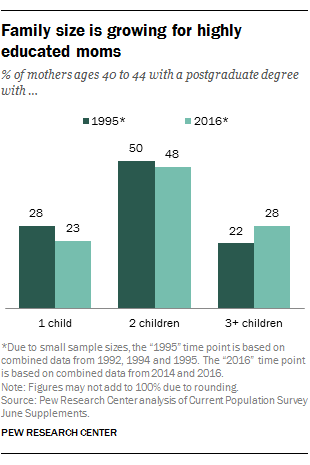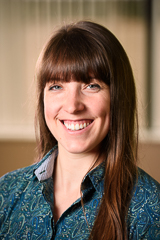How Many Kids Do the Average Family Have

Alee of National Center Child Day, some take recently pondered whether middle children are "going extinct." Yet new data on the number of children Americans encounter as "ideal" advise that middle-kid families could become more pop again: Roughly four-in-ten U.S. adults (41%) remember families of three or more children are ideal, a share rivaling that of effectually two decades ago, co-ordinate to a recent Gallup survey.
 The current share of adults who see three or more children as the ideal family unit size is the highest since 1997, when, amid a thriving economy, 42% said this. Withal, it is yet far beneath the share in 1967 and before, when a clear majority of Americans said three or more is the ideal number.
The current share of adults who see three or more children as the ideal family unit size is the highest since 1997, when, amid a thriving economy, 42% said this. Withal, it is yet far beneath the share in 1967 and before, when a clear majority of Americans said three or more is the ideal number.
Americans' preference for families with iii or more than children began to reject after the Baby Boom era and through the 1970s and '80s. It reached a low of 28% in 1986, subsequently a period of multiple recessions.
When it comes to the number of children that U.South. women are actually having in their lifetime, it's still much more mutual for women at the end of their childbearing years to have had one or ii kids than 3 or more than, co-ordinate to a Pew Inquiry Eye analysis of U.Due south. Census Agency data.
In 2016, about vi-in-x U.S. mothers ages twoscore to 44 (62%) had given birth to 1 or 2 children, while just 38% had iii or more. That'southward roughly the inverse of 1976, when most ii-thirds of mothers in this age range (65%) had iii or more than kids and 35% had one or two.
 A sharp decrease in the share of mothers with four or more than children has played a part in the long-term decline in larger families, according to the Census Bureau information. In 1976, four-in-ten moms in their early 40s had given birth to iv or more than children. But by 2016, the share had shrunk to just fifteen%. The three-child family unit, by dissimilarity, has held relatively constant: In both 1976 and 2016, roughly a quarter of mothers ages 40 to 44 had given nascency to three children.
A sharp decrease in the share of mothers with four or more than children has played a part in the long-term decline in larger families, according to the Census Bureau information. In 1976, four-in-ten moms in their early 40s had given birth to iv or more than children. But by 2016, the share had shrunk to just fifteen%. The three-child family unit, by dissimilarity, has held relatively constant: In both 1976 and 2016, roughly a quarter of mothers ages 40 to 44 had given nascency to three children.
Despite the dramatic decline of the four-child-plus family over the by few decades, the share of Americans who see four or more children as the ideal number is really ticking upward. In 2007, 9% of Americans said the ideal number of children is 4 or more, according to Gallup. That share grew following the Great Recession and now stands at 15%. In fact, since 2007, the increment in the boilerplate number of children Americans see as ideal is mainly due to a rise in the share of adults who retrieve iv or more kids is the ideal family size.
Instruction and family size
The number of children a family has, as well as views of the ideal number of children, vary past educational attainment. On average, the more than education a female parent has, the fewer children she will accept in her lifetime, equally previous Pew Research Center reports have shown.
In combined data for 2014 and 2016, 46% of mothers ages 40 to 44 with a loftier school diploma or less had given nascence to iii or more children. Past comparison, among mothers in the same age group with a postgraduate degree, 28% had given birth to three or more than kids.
 But the educational "gap" in fertility has somewhat narrowed in the past two decades, driven by declining childlessness and a rise in larger families amongst highly educated moms. The share of mothers ages 40 to 44 with at least a primary's caste and three or more children increased from 2 decades ago, equally the share with just one kid declined. Co-ordinate to previous research by the Center, highly educated women are the merely grouping with a failing share of one-kid families and a rise in families of iii or more.
But the educational "gap" in fertility has somewhat narrowed in the past two decades, driven by declining childlessness and a rise in larger families amongst highly educated moms. The share of mothers ages 40 to 44 with at least a primary's caste and three or more children increased from 2 decades ago, equally the share with just one kid declined. Co-ordinate to previous research by the Center, highly educated women are the merely grouping with a failing share of one-kid families and a rise in families of iii or more.
When information technology comes to platonic family size, highly educated adults are over again less likely to say having three or more children is platonic, according to Gallup. Amidst those with a postgraduate degree, 36% believe 3 or more kids are ideal, compared with 46% of those with no college education. Nevertheless, since 2011, the share of Americans who encounter families of three or more children as ideal has risen among all levels of educational activity.

Kristen Bialik is a former research banana at Pew Enquiry Heart.
Source: https://www.pewresearch.org/fact-tank/2018/08/09/middle-children-have-become-rarer-but-a-growing-share-of-americans-now-say-three-or-more-kids-are-ideal/
0 Response to "How Many Kids Do the Average Family Have"
Post a Comment